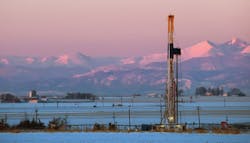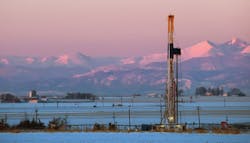SEC looks at E&P compliance with amended disclosure rules
Part Two of A Three-Part Series
Marc Folladori and Amelia Xu,Mayer Brown LLP, Houston
This is the latest in a series of articles that address publicly-held exploration and production (E&P) companies' compliance with the amended oil and natural gas disclosure rules adopted by the Securities and Exchange Commission (SEC) in late 2008.1 This is part two of a three-part series that started with the May issue.
Changes in estimates and revisions of PUDs and proved reserves
Closely related to the topic of PUDs development was the year-to-year changes in companies' reserve quantities. Item 1203 of Regulation S-K requires disclosure of material changes in PUD quantities occurring during the fiscal year, particularly conversions of PUDs to PDs, and the investments and progress (including capital expenditures) made during the year to convert those PUDs. As was the case during the 2011-12 period, many companies received comments in 2012-13 concerning these requirements. Disclosures of material changes to PUD quantities generally prompted staff requests for companies to provide additional information about the reasons for the changes and the components of the total changes — more specifically, the changes that were attributable to revisions, acquisitions, divestments, discoveries or extensions.
E&P companies are also required to present certain information about their oil and gas producing activities specified in Financial Accounting Standards Board Accounting Standards Codification (FASB ASC) Topic 932 — Extractive Activities—Oil and Gas. FASB ASC 932-235-50-5 requires a tabular presentation of the year-to-year changes in the net quantities of proved reserves. The table must present, as separate line items, the sources of the changes in the quantities that result from (i) revisions of prior estimates; (ii) reserves added by improved recovery methods; (iii) purchases of minerals in place; (iv) extensions and discoveries; (v) production; (vi) conversions to developed reserves; and (vii) sales of minerals in place. Many comments were issued in 2012-13 concerning this disclosure item.
Numerous staff comments during 2012-13 required companies to disclose their aggregate year-to-year change in their standardized measures under FASB ASC 932-235-50-35. Companies were requested to identify the sources of all material changes identified in FASB ASC 932-235-50-35 (e.g., net change in sales and transfer prices and lifting costs, changes in estimated future development costs, net change due to revisions in quantity estimates), and ensure that all adjustments were made in accordance with the definitions in Regulation S-X § 4-10(a).
Comment letters requested detailed explanations from companies as to (i) specific development activities that had been performed in converting PUDs to PDs, (ii) progress made with respect to significant properties relative to the five-year development time frame, particularly with reference to the capital expenditures incurred, (iii) reasons for not including the amount of change in proved reserves resulting from improved recovery methods and (iv) companies' development plans, including comprehensive information as to their development rate assumptions considered in light of a deterioration in the company's economic environment, drilling rig cancellations and ceiling test write-downs (Rex Energy Corp. (Dec. 21, 2012)). Where a company had disclosed that for $18 million in capital expenditures, it had developed 73 MBOE in reserves, resulting in unit costs of $247/BOE, the staff asked why those unit costs had been so high (Gulfport Energy Corp. (July 17, 2013)).
The staff was also critical of companies not separating their annual net reserve quantities as of the beginning and the end of the year into separate categories of total proved reserves, total PUDs and total PDs, as required under FASB ASC 932-235-50-4 (Swift Energy Co. (Aug. 2, 2013)). Companies were also asked for information as to major discoveries or other favorable events that caused an increase in proved reserves.
Downward revisions to prior reserve estimates due to production performance drew comments to explain the circumstances of the reductions and, importantly, the steps the company had taken to avoid further net negative revisions (CAMAC Energy Inc. (Dec. 20, 2012)). Where a company had disclosed that certain of its PUDs had a "negative present worth" when valued under the SEC's mandated 10%-discount and constant-prices-and-costs standardized measure, the staff requested that the company disclose the number of locations and the net quantities of natural gas, oil/condensate and natural gas liquid (NGL) reserves attributable to those locations having negative present worth (Goodrich Petroleum Corp. (Sept. 25, 2012)).
Production, present activities and trends
The staff continued to focus on companies' production disclosures during the 2012-13 review period, particularly information regarding annual production volumes, average sales prices and average production costs per unit of production, as required under Item 1204 of Regulation S-K. The staff asked whether companies had correctly computed their average production costs per unit by excluding ad valorem and severance taxes from their calculations (Murphy Oil Corp. (June 3, 2013)). Likewise, where a company had attributed a portion of the increase in its lease operating expenses to production taxes, the staff directed the company to disclose its unit production costs without the effect of production taxes, but suggested that the effect of the production taxes could be explained in a footnote (PrimeEnergy Corp. (Dec. 4, 2012)). Where appropriate, the staff stressed that disclosures should include all categories of oil, gas and other products produced, including synthetic oil where synthetic oil reserves were disclosed.
Many companies received comments about their present activities and discernible trends in their operations. A small company's third-party engineering report indicated that the company was planning to drill 230 wells at a completed well cost of $361,000 per well (totaling $83 million). The staff requested information from the company about any proposed financing arrangements to fund the $83 million capital costs for drilling, and noted that Regulation S-X § 4-10(a)'s definition of reserves requires a minimum expectation that the "financing required to implement the project" would exist (Far East Energy Corp. (Sept. 25, 2012)). The staff questioned one company as to why its share of net production from certain fields had varied materially from period to period (CAMAC Energy Inc. (Dec. 20, 2012)). Another comment letter requested further information about a company's capital expenditure strategy where the company had disclosed that it planned to spend 70% of its 2012 budget to drill wells on locations that represented only a small portion of the company's PUDs, as of the end of its fiscal 2011 (Goodrich Petroleum Corp. (Sept. 25, 2012)).
Natural gas liquids (NGLs)
Given the lower prevailing price regime for North American natural gas in recent years, many companies have changed their development focus from finding and producing dry gas to finding and producing higher-priced crude oil and NGLs. There were numerous staff requests during the 2012-13 period for companies to break out separately their disclosures concerning their NGL reserves from their other reserve categories. A recent Wall Street Journal article ("Oil Firms Queried on Reserves," Sept. 13, 2013) discussed staff views on separating NGL reserves from other categories (principally crude oil), since the staff views NGLs as a "separate product type" and Regulation S-K 1202(a)(4) requires reserves to be disclosed by product type. The staff's obvious concerns relate to the price differential that exists between NGLs and crude oil.
FASB ASC paragraph 932-235-50-4(a) requires separate disclosures of reserve quantities for NGLs if the NGLs are "significant." Where NGLs production had constituted 6% of a company's total fiscal 2012 production, the staff instructed the company to break out its NGL reserve disclosures separately (BHP Billiton Limited and BHP Billiton Plc (March 5, 2013)). Other companies receiving similar comments included ConocoPhillips (NGLs were 9.2% of its total 2011 production), and Total (NGLs represented 6.0% of its total proved reserves as of December 31, 2011), as well as smaller independents, such as Whiting Petroleum (NGLs were 11.2% of its total liquids production) (Whiting Petroleum Corp. (Aug. 29, 2012)).
Item 1204 of Regulation S-K also requires disclosure of a company's production of oil, gas and other products "by final product sold" for each of the three prior fiscal years. An instruction to Item 1204 provides that natural gas production should include only the marketable production of natural gas on an "as sold" basis, and that gas consumed in operations should be omitted from the final production quantity disclosures. A number of staff comments questioned whether companies' disclosed natural gas production volumes had been correctly presented as the instruction requires, or whether gas used in processing NGLs had been incorrectly included in total gas production volumes (Murphy Oil Corp. (Jun. 3, 2013)). Where a company had disclosed its interests in synthetic oil reserves, the staff asked the company whether those reserves represented hydrocarbons from coal reserves in which it had an underlying direct ownership interest and exclusive of any coal it had otherwise purchased. The company responded that it had excluded from its calculations all external coal purchased, export coal and coal used for utilities (Sasol Ltd. (June 28, 2013)).
One company's fiscal 2011 10-K filing and related staff comments illustrate the nuances involved in disclosures about the differing classifications of natural gas liquids. Clayton Williams Energy, Inc. had disclosed that, in calculating its present value of future net cash flows from proved reserves as of December 31, 2011, the benchmark average price for natural gas reserves had been $4.21 per MMbtu, but that this benchmark price had been adjusted by the company for quality, energy content, transportation fees and other price differentials, resulting in an average adjusted price of $5.31 per Mcf. The staff asked the company about the extent that the price differentials related to unprocessed gas elements that had different market price sensitivities, and whether adjusting the benchmark price by itself had fully disclosed the company's expectations about the sustainability of its gas revenues and the stability of its gas reserve estimates (Clayton Williams Energy Inc. (Dec. 12, 2012)). The company explained in its response letter that a large part of the price differentials had to do with the fact that most of its natural gas production consisted of casinghead gas, which had high embedded-NGL content. The company agreed that in its subsequent filings it would provide additional information to clarify the extent to which its gas price differentials pertained to its unprocessed NGL components, and discuss the extent to which the value of its financial results and financial condition depend on maintaining those differentials.
Another company disclosed its nonconventional oil sands projects in Canada and the process involved to extract the bitumen over the life of the projects. Regarding its production disclosures, the staff asked the company to disclose bitumen separately from crude oil as a final product sold under Item 1204(a) of Regulation S-K (Devon Energy Corp. (Dec. 13, 2012)).
A federal district court's holding in a June 2013 case illustrates potential problems that can arise from companies' non-precise disclosures with respect to the marketable production of natural gas. In 2008, Sandridge Energy Inc. had raised funds from private investors, including Patriot Exploration LLC, to help fund Sandridge's E&P program to supply natural gas volumes to a gas gathering and treatment plant. Sandridge had shown Patriot a PowerPoint presentation that indicated a 26% rate of return to investors in the program based on Sandridge's projected sales of the gas it produced. Patriot later sued Sandridge in the United States District Court for the District of Connecticut, claiming that Sandridge had made numerous misrepresentations to Patriot about the projected gas sales from the properties in which Patriot was invited to co-invest.
One of Patriot's claims was based on an allegation that Sandridge's rate of return forecast had not taken into account gas plant shrinkage (i.e., the volume of natural gas utilized as fuel to run the gathering and treatment plant and the methane and other gases lost during the treatment process). Patriot alleged that, after giving effect to the loss of gas volumes due to "plant shrink," the actual volumes of gas available for sale were only one-half of that projected by Sandridge in its presentation.
Sandridge filed a pre-trial motion to dismiss Patriot's claims. At a hearing on this motion, the federal district court judge denied in part Sandridge's motion to dismiss for various reasons. Among these reasons was that it appeared that Sandridge's methodology applied in its presentation for calculating gas available for sale had not been consistent with the PRMS guidelines or SEC rules. Patriot Exploration LLC, et al., v. Sandridge Energy Inc., et al., ___ F. Supp. 2d ____ (June, 29, 2013), 2013 WL 3285118 (US Dist. Conn. 2013).
Engineering information
Companies continued to receive comments in 2012-13 pointing out deficiencies in their reserve engineering disclosures, many regarding the third-party engineers' reports included as exhibits to their filings. A number of comments noted that the filed third-party engineers' reports did not comply with Item 1202(a)(8) of Regulation S-K, which requires that specific disclosures be made in the report – disclosures such as the engineers' role in connection with the report's preparation, the proportion of the company's reserves covered by the report and the assumptions, data and methods used by the engineers. One engineering report was cited by the staff for numerous omissions of required Item 1202(a)(8) information, including disclosure of the date on which the report had been completed and required statements addressing the inherent uncertainties involved with reserve estimates. The report had also utilized certain terms that did not conform to the definitions in Regulation S-X §4-10, and included estimates of probable reserves although the forepart of the filing had not included any references to probable reserves. The company was asked to file a revised engineering report or else amend its filing to include probable reserves estimates (Devon Energy Corp. (Dec. 13, 2012)).
Another comment letter criticized a company's stating that its independent petroleum engineering consultant had prepared its reserve estimates in accordance with "generally accepted petroleum engineering and evaluation principles," pointing out that there was no official industry compilation of these principles (Far East Energy Corp. (Sept. 25, 2012)). The staff also found fault with an engineering report that did not include the disclosures required under Regulation S-K Item 1202(a)(7) concerning the qualifications of the technical person primarily responsible for overseeing the preparation of the estimates, and other reports that contained information inconsistent with information contained in the forepart of the filings (Contango Oil & Gas Co. (July 11, 2013); EV Energy Partners LP (Sept. 11, 2013)).
Consistent with the 2011-12 review period, the staff requested detailed reserve engineering data and related information as supplemental information from many companies. Requests included comprehensive data about reserves that were scheduled to be drilled more than five years after their initial booking relating to a project the company claimed to be a "development project" (Approach Resources Inc. (Jan. 22, 2013)), and technical information in support of a company's claim of the estimated economic recovery of 72.8 billion cubic feet of gas relating to specified fields in Malaysia (Murphy Oil Corp. (June 3, 2013)). Often requested were individual and summary income forecasts and engineering exhibits regarding a company's estimated volumes for a field or formation, such as maps, rate/time plots, volumetric calculations and analogy well performance. The staff asked another company for data to support its claims of the producibility of 20,000 "potential" barrels of oil per day from an offshore West Africa well. The information requested had to show (i) an estimate of the initial production rates when well development began, (ii) the total recovery from the development test and (iii) shut-in and flowing pressures at the beginning and at the conclusion of the test (Cobalt International Energy Inc. (Sept. 13, 2012)).
About the Authors
Marc Folladori has been a merger and acquisition and securities attorney in Texas since 1974, and has extensive experience representing energy companies and firms engaged in energy investment and finance. He serves as outside corporate counsel for a number of publicly-held corporations and also provides US counsel to foreign companies doing business in the US.
Amelia Xu is an associate in Mayer Brown's Houston office and a member of the firm's Corporate & Securities and Energy practices. She focuses her practice on mergers and acquisitions, securities offerings and general corporate matters. She represents both US-based and international energy companies (including oil and gas exploration and production, electricity, oilfield equipment, and other energy services companies) in the acquisitions of US companies and assets, and international oil and gas interests around the world.
1The three prior articles are: "Studies show further guidance needed on revised oil and gas disclosure rules," 7 Oil & Gas Financial Journal, number 12, pg. 22 (December 2010), available at http://www.ogfj.com/index/article-display/3482369705/articles/oil-gas-financial-journal/volume-7/issue-12/features/studies-show-further-guidance-needed-on-revised.html; SEC doubts companies' ability to book PUDs beyond 5 years," 8 Oil & Gas Financial Journal, number 8, pg. 8 (August 2011), available at http://www.ogfj.com/articles/print/volume-8/issue-8/departments/capital-perspectives/sec-doubts-companies-ability-to-book.html; and "SEC comments on companies' compliance with amended oil and gas disclosure rules," 9 Oil & Gas Financial Journal, number 12, pg. 26 (December 2012), available at http://www.ogfj.com/articles/print/volume-9/issue-12/features/sec-comments-on-companies-compliance.html; and 10 Oil & Gas Financial Journal, number 1, pg. 34 (January 2013), available at http://www.ogfj.com/articles/print/volume-10/issue-1/features/SEC-comments-on-companies-compliance.html (published in two parts).



